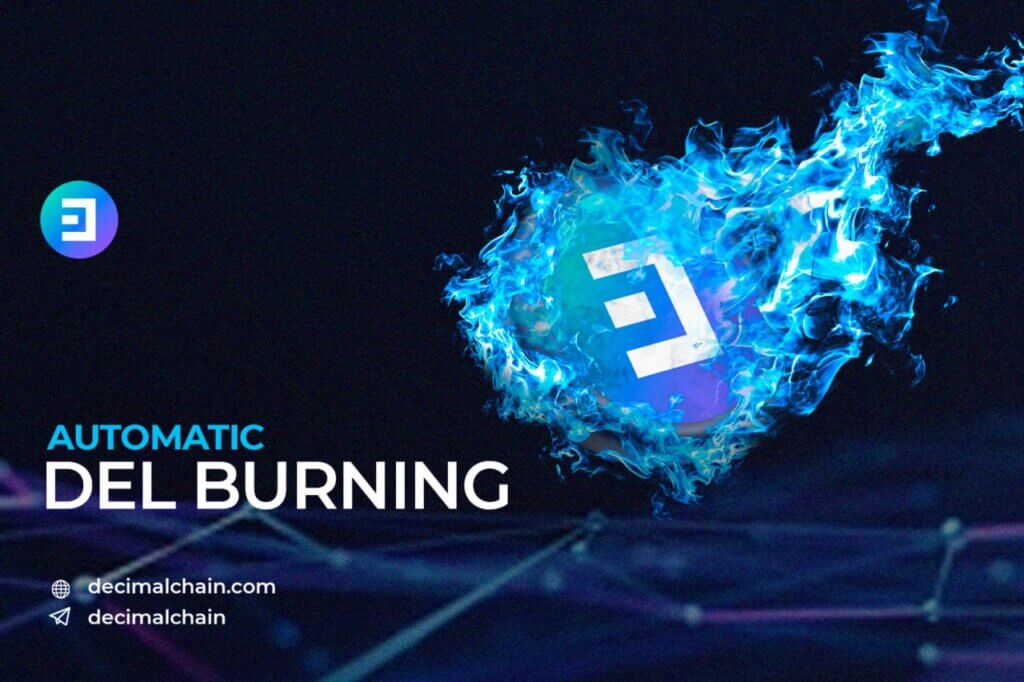Automatic DEL burning
This article will explore the coin-burning process in the Decimal blockchain. How has it affected DEL the base token in the network, how does the burning occur on the chain, and who can do it? Read on so you’ll find the answers to the questions (and even more).
DEL Supply
Before we examine how coin burning goes, it is worth paying attention to the process of creating coins named issuance.
Issuance is the process of generating a certain amount of coins per block calculation and this process is one of the tools for blockchain development and audience engagement.
DEL issuance is composed of the base reward per block and the total fee of all transactions in the block. We recommend reading chapter 6 “DEL issuance” in Yellow Paper for a more detailed review of the issuance mechanism with formulas and calculations for future years.
After two years of blockchain running, the current issuance is 2,768,690,882.45 DEL, while 2,582,280,495.12 DEL (93%) of these are in the delegation. Such a high percentage of delegated coins indicates the interest of the audience in the long-term prospects of blockchain and choosing a holding strategy at the first stage. According to the Economic Guide, the total issuance Economic Guide is set at 92,075,616,000 DEL.
Validators — are the members of the chain responsible for adding new blocks and recording information, they also receive generated coins. That “network reward” is then distributed to the delegators who are the users who have sent in their coins for delegation.
There are over 60 validators in Decimal and, they need to be rewarded for their work. This way, they can pay for server hardware and cover other costs. Those users who have researched the project themselves and see a prospect in it, are interested in receiving staking at the early stages, to accumulate as many coins as possible during the holding period without any additional expenses.
Most likely, there is a reasonable question for each of you: why do the developers set up the issuing process with complicated formulas and paperwork, more like research reports, and then implement tools to control the issuing, such as burning?
Coin burning
is the process of permanently removing a certain number of coins from circulation. Burned coins cannot then be used or appropriated by anyone.
This process is a deflationary mechanism and keeps the balance between DEL issuance and consumption. Thereby issuance attracts more users who perform more actions: putting liquidity into new tokens, making transactions, and creating NFTs, which results in regulating the circulating supply. It is shown that token burning positively affects the coin’s price.
Burning in Decimal
The burning mechanics have been designed from the beginning and was opened to users in Q3 2022 along with the automatic network update.
The tokens used for burning were accumulated in a special wallet and then burned by the team. The first occurred on 18 July, when 155,041,971 DEL were irrevocably deleted from circulation. Only 5% of the coins remained in free circulation for the technical needs of the exchanges and platforms on which the DEL token is represented at the time after the first burning.
The second burning took place on 18 October, in Q4 2022 already, 52,466,758 DEL was gathered from the developers’ wallets and was irrevocably removed from the total DEL issue.
Additional features of burning in Decimal
What tokens can be burned?
Any user can personally participate in burning tokens and not only the base DEL but also all custom tokens backed by it. The mechanism is available in the User Console with attention: when a custom token is burned, only its issuance is reduced, not its reserve. Let’s look at the example of one of the most popular tokens on the network, BTT.
A while ago, BIT.TEAM, the company that created the BTT token, carried out a quarterly token burn. The company burns 20% of the profits earned on providing the services at the end of the quarterly accounting period. At that point, the amount to be withdrawn was 6,000,000 BTT. After the burning transaction, the issuance decreased by the number of tokens burned and became 454,999,925.18 BTT, but the BTT token reserve is in DEL and remains the same at 3,949,953 DEL.
50% Auto-burn of Transaction Fees
On 14 December, Decimal’s mainnet completed the transition to Decimal Smart Chain. As a result, several additional features have appeared, one of them being related to burning.
The Decimal Smart Chain automatically burns 50% of the network’s transaction fees. It also has its specifics, which we will explore.
If the fees were paid in DEL, then, as the general burning, the current token issuance is reduced by the corresponding number of tokens burned. But if the fee was paid in a custom token, the supply and reserve are reduced by the number of tokens taken out of circulation.
At the time of writing, the DSC network has burned in total 211,260,057.475 DEL. This amount includes the first quarterly burn of 155,041,971 DEL and the second of 52,466,758 DEL. Currently, there is no need for separate burning, thanks to the automatic burning of the commission. All information on the burn can be found at explorer.decimalchain.com and the company’s social media channels.
Subscribe to the official media channels and stay up to date with everything!
